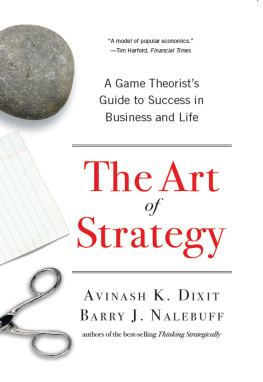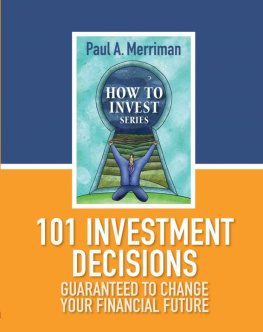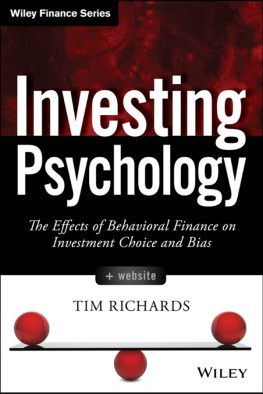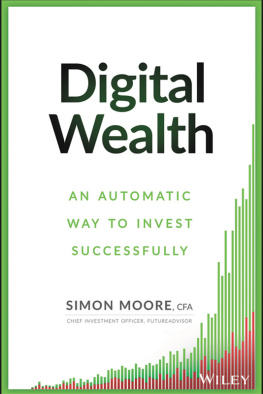Investment under Uncertainty
Investment under Uncertainty
Avinash K. Dixit and Robert S. Pindyck
Princeton University Press
Princeton, New Jersey
Copyright 1994 by Princeton University Press
Published by Princeton University Press, 41 William Street, Princeton, New Jersey 08540
In the United Kingdom: Princeton University Press, Chichester, West Sussex
All Rights Reserved
Library of Congress Cataloging-in-Publication Data
Dixit, Avinash K.
Investment under uncertainty / by Avinash K. Dixit and Robert S. Pindyck
p. cm.
Includes bibliographical references and index.
ISBN-13: 978-0-691-03410-2 ISBN-10: 0-691-03410-9
1. Capital investmentsDecision making. I. Pindyck, Robert S. II. Title.
HG4028.C4D58 1993 658.15'54dc20 | 93-26321
CIP |
This book has been composed in Times Roman
Princeton University Press books are printed on acid-free paper and meet the guidelines for permanence and durability of the Committee on Production Guidelines for Book Longevity of the Council on Library Resources
http://pup.princeton.edu
Printed in the United States of America
10 9 8
To the future
Contents
Preface
THIS BOOK provides a systematic treatment of a new theoretical approach to capital investment decisions of firms, stressing the irreversibility of most investment decisions and the ongoing uncertainty of the economic environment in which those decisions are made. This new approach recognizes the option value of waiting for better (but never complete) information. It exploits an analogy with the theory of options in financial markets, which permits a much richer dynamic framework than was possible with the traditional theory of investment.
The new view of investment opportunities as options is the product of over a decade of research by many economists, and is still an active topic in journal articles. It has led to some dramatic departures from the orthodox theory. It has shown that the traditional net present value rule, which is taught to virtually every business school student and student of economics, can give very wrong answers. The reason is that this rule ignores irreversibility and the option of delaying an investment. For the same reason, the new theory also contradicts the orthodox textbook view of production and supply going back to Marshall, according to which firms enter or expand when the price exceeds long-run average cost, and exit or contract when price falls below average variable cost. Policy prescriptions based on the traditional theory, for example, the use of interest rate cuts to stimulate investment and antitrust policies based on price-cost margins, are also called into question.
In this book we have tried to present the new theory in a clear and systematic way, and to consolidate, synthesize, and in some places extend the various strands of this growing body of research. While there is a large and burgeoning literature of journal articles, including a survey article by each of us, a book format has distinct advantages. It offers us the space to develop the different themes in more detail and better order, and to place them in relation to one another. It also gives us the opportunity to introduce and explain the new techniques that underlie much of this work, but that are often unfamiliar to economists. We hope that the result is a better pedagogic treatment, of use to students, researchers, and practitioners. However, perhaps even more important than pedagogy is the ability of the book format to provide a broad vision of the subject, and of the mechanisms of the dynamic, uncertain economic world.
Our main aim is to clarify and explain the theory, but we think this is often best done by applying it to the real world. Therefore we often obtain numerical solutions for our theoretical models using data that pertain to some specific industries or products. We believe that the cumulative weight of these calculations constitutes strong prima facie evidence for the validity and the quantitative significance of the new theory of investment. However, more rigorous econometric testing, and the detailed work that is needed to devise improved decisionmaking tools for managers, await further research. We believe that this is an exciting and potentially important subject, and hope that our book will stimulate and aid such research.
Who Should Read This Book?
This book is intended for three broad audiences. The first audience consists of economists with an interest in the theory of investment, and in its policy implications. This includes graduate students engaged in the study of micro- and macroeconomic theory as well as industrial organization, and researchers at universities and other institutions with an interest in problems relating to investment. The second broad audience is students and researchers of financial economics, with an interest in corporate finance generally, and capital budgeting in particular. This would include graduate students studying problems in capital budgeting (that is, how firms should evaluate projects and make capital investment decisions), as well as anyone doing research in finance with an interest in investment decisions and investment behavior. Finally, the third audience is finance practitioners. This includes people working in financial institutions and concerned with the evaluation of companies and their assets, as well as corporate managers who must evaluate and decide whether to go ahead with large-scale investments for their firms.
Some parts of this book are fairly technical, but that should not deter the interested reader. The first two chapters provide a fairly brief and self-contained introduction to the theory of irreversible investment under uncertainty. These chapters convey many of the basic ideas, while avoiding technical details and any mathematical formalism. Reading these chapters is a low-risk investment that we can almost guarantee will have a high return. Even those practitioners whose knowledge of economics and finance textbooks is very rusty should be able to follow these two chapters without too much effort or difficulty.
We anticipate that many readers will want to go into the theory in more detail and address some of the technical issues, but lack some of the necessary mathematical tools. With those readers in mind, we have included two chapters (chapters 3 and 4) that provide a self-contained introduction to the mathematical concepts and tools that underlie this work. (These tools have applicability that goes well beyond the theory of investment under uncertainty, and so we anticipate that some readers will find these chapters useful even if their applied interests lie elsewhere, for example, macroeconomics, international trade, or labor economics.)
However, we think that techniques are best learned by using them. Therefore we do not attempt to be very rigorous or thorough in the mathematics as such. We rely on intuition as far as possible, sketch some simple formal arguments in appendices, and refer the readers who wish greater mathematical rigor or depth to more advanced treatises. For most readers, we recommend reading chapters 3 and 4 once, and proceeding to the later chapters where the techniques are used. We think they will emerge with a much better grasp of the mathematics in this way than by trying to master it first and in the abstract.
Finally, we expect that many readers will want to see the new view of investment developed in detail, including as many of its ramifications as possible, along with examples and applications. Chapters 5 through 12 provide just that, building up slowly from a basic and fairly simple model of irreversible investment in chapter 5, to more complete models in chapters 6 and 7 that account for decisions to start or stop producing, to the models in chapters 8 and 9 that account for the interactions of firms within industries, and finally to the more advanced extensions of the theory and its applications in Chapters 10, 11, and 12.








